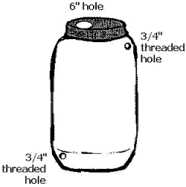
Rain Barrel Information
How
to make your own rainbarrel:

Step 1
-
Use a 6" hole saw, a saber saw, a keyhole saw or a drywall saw to cut a perfectly round 6Ē hole on the top of your barrel. Drill two holes with a 29/32Ē drill bit, one towards the top for an overflow and one towards the bottom of the barrel for the faucet.
- Next use a 3/4" NPT pipe tap and twist it into the upper 29/32" hole, then untwist the tap and back it out of the hole, then repeat the same process for the lower 29/32" hole
-
Rinse your barrel out thoroughly, as it previously had a food product in it. Avoid using bleach, as it is environmentally harmful in the storm drains. For an environmentally safe soap solution use 2 teaspoons of castile soap and 2 teaspoons of vinegar or lemon juice for every gallon of water used to clean your barrel.
Step 2
-
Twist in the threaded side of the hose adapter into the 3/4" threaded hole towards the top of the barrel.
- Prepare the threaded side of the brass faucet by:
- Wrapping it tightly with teflon tape, make four or five rotations until all the threads are covered; or
- Applying a thin ribbon of Kitchen and Bath All Purpose Adhesive Caulk, or similar sealant.
-
Twist in the threaded and now prepared end of the faucet into the 3/4" threaded hole towards the bottom of the barrel.

Step 3
- Cover the 6" hole in the top by placing the 6" louvered screen onto the barrel with the louvered side up and the screen side down. Slide a hose onto the hose adapter at the top of barrel to direct the overflow water away from your home.
- Place two cinder blocks under the selected downspout and place the barrel on this raised base.
- Cut your downspout about 4" above the top of the barrel, add an elbow, and make any final adjustments to the base and barrel.
- Add a hose on the faucet or keep it available to fill a watering can.
- Enjoy your rain barrrel!

YOU
WILL NEED: a drill, a 6" hole saw (a saber saw, a keyhole saw, or
a drywall saw will also work), a 29/32" drill bit, a 3/4" pipe
tap, 6" louvered screen, 3/4" brass faucet, Teflon tape or all
purpose caulk, 3/4" hose adapter, and last but not least, a barrel
to suit your needs.
Plastic barrels are used for shipping and
storage of nice things like chutneys and olives, and not-so-nice things
like pesticides and heavy-duty detergents. Sometimes, the outside of a
barrel will tell you what it contained, but thereís no guarantee it hasnít
been refilled with something else. Know where your barrel comes from and
make sure itís clean!